
Prime rib is one of those cuts I only cook a few times a year, usually for Christmas dinner or Easter lunch. Let’s be real, it is a very expensive piece of meat, so there isn’t much room for mistakes.
For years, I relied on store-bought seasonings, but most were either too sweet or had long ingredient lists that took over instead of supporting the meat.
So I started testing my own blend using basic ingredients I already had on hand. I kept adjusting the ratio until the herbs added gentle warmth, the garlic complemented the meat, and the salt brought everything together. I think these 5 ingredients are more than enough, but I also included optional add-ins in case you want to make it your own.
Whether you season the roast a day or two ahead or prepare everything the same day, this has become the mix I reach for. And you can stir it together faster than it takes to find a seasoning at the store.
Another bonus? As the meat cooks, this blend seasons the pan drippings perfectly, giving you a head start on a rich Prime Rib Au Jus you can make in minutes.
Prime Rib Seasoning Ingredients
Before you start mixing your seasoning, here’s a quick look at what goes into this seasoning for prime rib roast and a few easy substitutions if you need them:
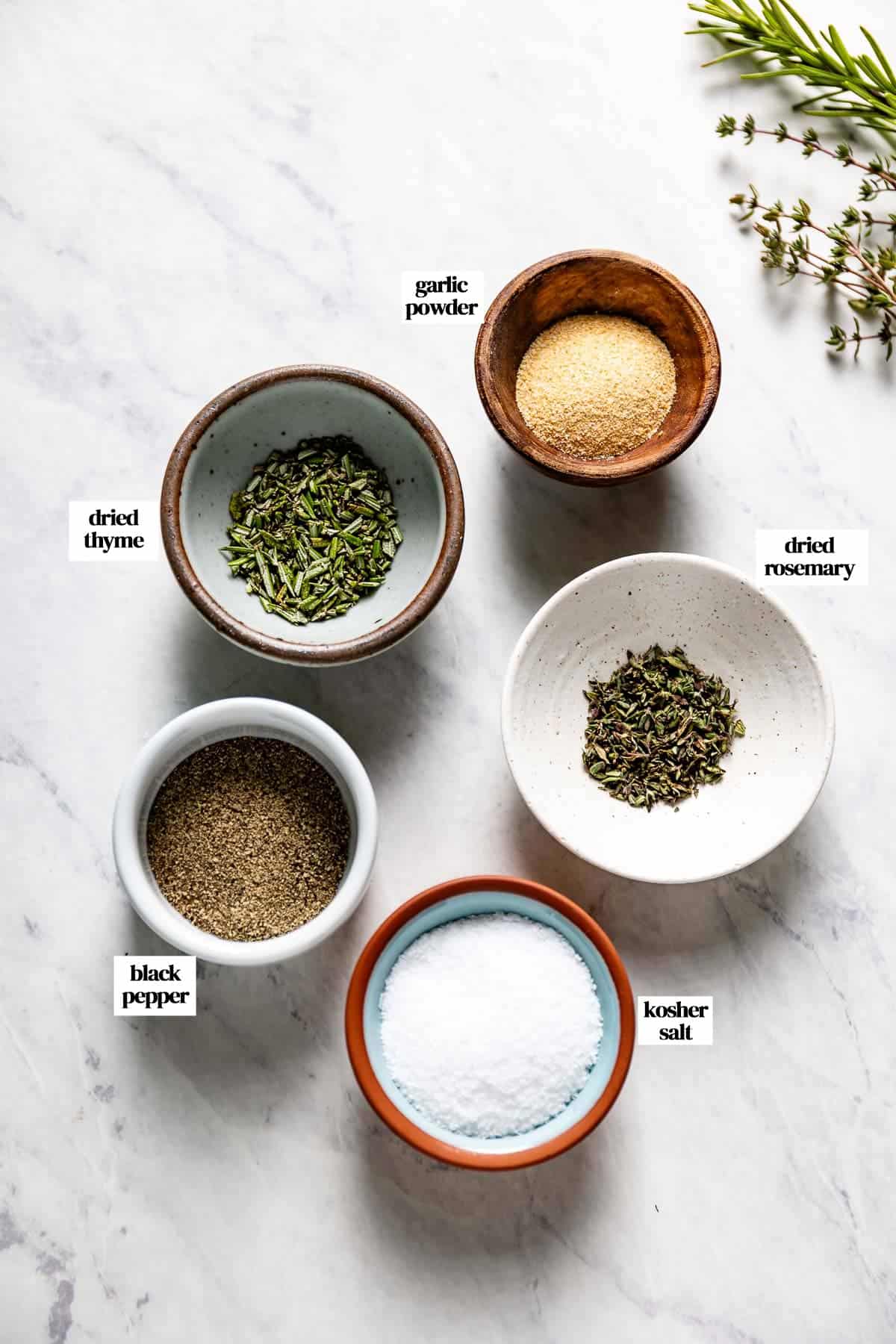
Kosher salt: I prefer Diamond Crystal because its larger flakes make it easier to control the seasoning. If you are using Morton Kosher Salt, use half the amount since the grains are denser and saltier.
Pro tip: If you are dry-brining your roast ahead of time (meaning you are pre-salting your meat 24-48 hours prior to cooking), omit the salt from this rub. Adding it twice would over-season the meat.
Black pepper: While both work, I highly recommend using coarse black pepper over fine black pepper, which will give you that classic steakhouse crust and holds up well during long roasting times.
Rosemary: I usually use dried rosemary for convenience, but fresh works too. If you use fresh rosemary, use twice as much as dried. Regardless of which one you use, be sure to chop it finely so you don’t end up with needle-like pieces.
Thyme: Similar to rosemary, I opted for dried thyme, but if you have fresh thyme, that would work too. If using fresh, double the amount.
Garlic powder: I opted for garlic powder as it can handle high heat, whereas fresh garlic tends to burn and turn bitter during high-heat roasting.
Optional Prime Rib Seasoning Variations
My approach to this prime rib seasoning recipe is to keep it simple, as it already has a naturally rich flavor. However, you can experiment with different spices and seasonings to achieve a different flavor profile.
If you decide to use one (or more) of the prime rib spices below, I recommend starting with a small amount (no more than ½ teaspoon to a teaspoon) and adding more as needed so you don’t overseason your meat.
- Onion powder: Onion powder is a bold addition that can immediately satisfy anyone who loves a robust flavor profile.
- Paprika: Paprika adds a warm, subtle smokiness to the rub. You can use regular or smoked paprika, whichever you prefer.
- Red pepper flakes: If you want a little heat, add a pinch. It gives the rub a subtle kick without overpowering the meat.
- Brown sugar: A small amount of brown sugar helps with caramelization, helping create that dark, crisp crust.Though please keep in mind that a little bit of sugar goes a long way.
- Oil: If you choose to make a wet rub, I recommend using an oil with a high smoking point, such as avocado oil, olive oil, or ghee, to avoid burning. I would recommend using 4-5 tablespoons of oil for a 7-pound prime rib.
- Dijon mustard: Even a small amount of Dijon adds a light tang and helps the seasoning stick to the roast. It gives the beef a subtle sharpness without overpowering the other flavors.
When To Season Your Prime Rib? Dry Brining vs Immediate Seasoning
Before we get to the instructions, I want to clarify something crucial regarding when you plan to season your roast, as this determines how you mix the spices. The best time to season prime rib depends on how much time you have.
However, both methods would work whether you are roasting, reverse searing, or smoking your prime rib.
You have two options:
Option 1: Dry Brining (Plan Ahead) – Recommended:
This is when you salt your meat 24-48 hours before cooking (which I use in my Reverse Sear Prime Rib recipe). I prefer this method because salting such a large cut early helps draw out moisture, dries the surface, and gives the salt enough time to permeate deep into the meat. To me, this is the secret to a perfectly seasoned prime rib.
How to do it: If you go this route, do not add salt to the seasoning mix below. Instead, salt your meat now and let it rest in the fridge for 24 to 48 hours. Mix the remaining ingredients and apply them to the rested meat right before cooking.
Option 2: Immediate Seasoning (Cook Today):
This is when you are short on time, and you plan to cook your prime rib today.
How to do it: Simply add the salt to the spice mix as written below and season your meat generously right before cooking.
How to Make Prime Rib Seasoning
Once you decide on your timing, putting it together takes a few minutes. Think of this prime rib seasoning blend as your base mix for any standing rib roast you make.
The steps are simple, but a few small details make a big difference in how evenly the seasoning sticks and how your crust turns out. Here is how I make it:
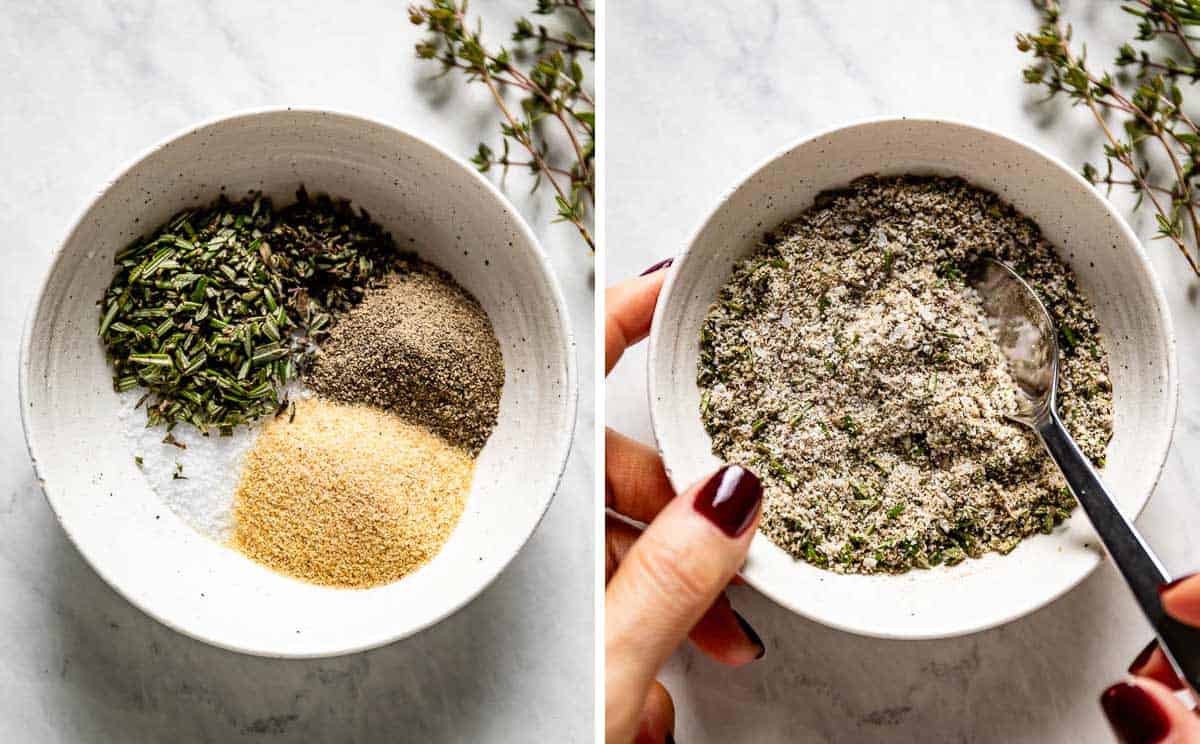
Step 1 – Mix all dry ingredients: Start by adding the kosher salt (if immediately seasoning), black pepper, rosemary, thyme, and garlic powder to a small bowl. Try to break up any lumps that you see. I like using a spoon or a small whisk.
Pro Tip: If you are using fresh, finely chopped herbs instead of dried, rub them gently between your fingers as you add them. This helps release their natural oils and gives the rub more aroma.
Step 2 – Rub onto roast or store for later: At this point, you can go in two directions:
- Using it right away: Pat your prime rib dry with paper towels so the surface is not wet. This helps the rub stick better and gives you a nicer crust. Before seasoning, let the roast sit at room temperature for 45 to 60 minutes to help it cook more evenly from edge to edge.
How To Do It: Sprinkle the seasoning all over the roast, including the sides and any crevices, and use your hands to gently press it in. Once it’s seasoned, place it on a roasting pan with a rack and proceed with your preferred cooking method. - Saving it for later: If you are prepping ahead, transfer the seasoning to a small jar with a tight-fitting lid. Store it in a cool, dry place. It will keep well for several weeks, which makes it easy to have the seasonings you need for your next prime rib roast ready, whether you are making it for the holidays or a special dinner.
How To Do It: Before you cook, give the jar a quick shake in case any of the spices have settled. Then use it just as you would a store-bought seasoning.
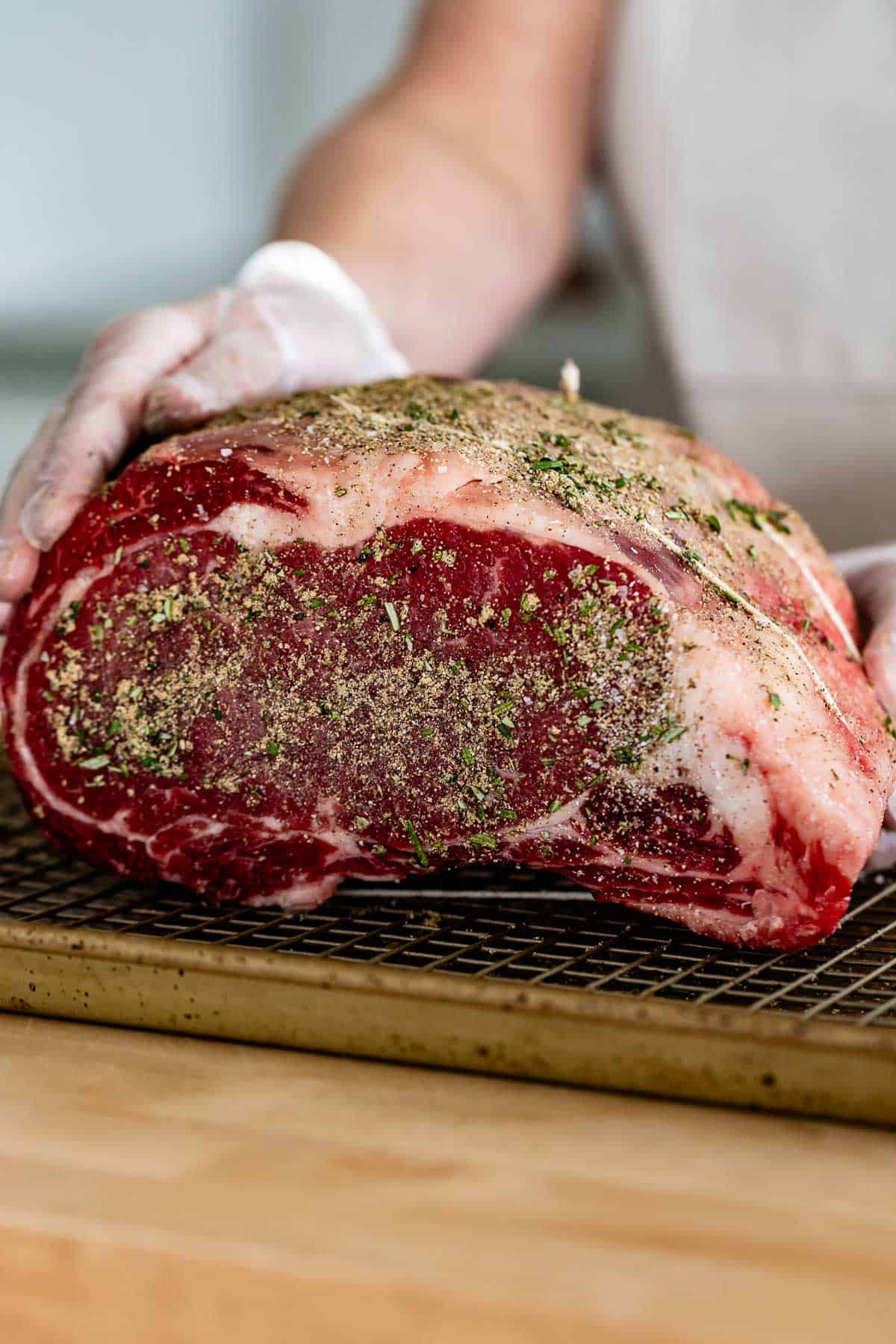
How Much Prime Rib Seasoning You Need (Per Pound Guide)
The amount of seasoning you need depends on the size of your roast. A good rule of thumb is to use about ½ to 1 tablespoon of seasoning per pound of meat. However, if your roast has a thicker fat cap, I recommend leaning towards the higher end of the range.
My recipe here makes 4 tablespoons of seasoning, for reference.
Here is a quick table you can follow when measuring out your rub:
| Roast Weight | Seasoning Needed |
| 5 lb / 2.26kg | 3 Tbsp |
| 6–7 lb / 2.72kg – 3.18kg | 4 Tbsp |
| 8–10 lb /3.63kg – 4.54kg | 5–6 Tbsp |
Expert Tips for Best Results
Having been making this recipe for several years now, I’ve learned a couple of tricks that make a big difference in how your seasoning sticks, how your crust turns out, and how evenly your roast cooks.
Dry the roast well: Before you season it, pat it dry with paper towels. A dry surface helps the rub cling to the meat and gives you a better crust. If the roast is a little wet, the seasoning can slide off.
Know the best time to salt your meat: Some recipes call for a dry brine 24 to 48 hours ahead, while others season right before cooking. Know which method you will be following to prevent over-salting the meat.
Evenly distribute it on all sides: Make sure you coat every part of the roast, including the fat cap and the sides. Since prime rib is thick, seasoning only the top will not give you the full flavor you want in each slice.
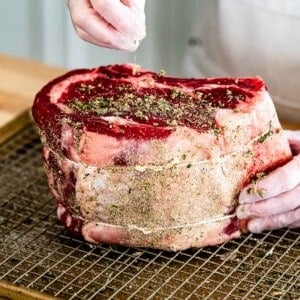
Prime Rib Seasoning Recipe
Ingredients
- 2 tablespoons of kosher salt*
- 1 tablespoon black pepper, coarsely ground
- 1 ½ teaspoons dried thyme, or 1 tablespoon fresh thyme (chopped)
- 1 ½ teaspoons dried rosemary, or 1 tablespoon fresh rosemary (chopped)
- 2 teaspoons garlic powder
Instructions
- Mix together the salt*, black pepper, dried thyme, dried rosemary, and garlic powder in a small bowl. Mix until combined.
- Spread the spice mixture evenly on your seasoned prime rib before cooking. Alternatively, you can store the mixture in a jar and store it until you are ready to use it.
Notes
- Yields: This recipe makes 4 tablespoons of prime rib seasoning (including the salt), enough for a 7-pound prime rib roast. You can multiply the recipe if you are cooking a larger roast.
- Kosher Salt: We used Diamond kosher salt in this recipe. If you are using Morton kosher salt, please use half the amount.
- Read your prime rib recipe fully before preparing this spice mix: Before making and using this spice mixture, be sure to check the recipe you are using, as some prime rib recipes (such as our Reverse Sear Prime Rib recipe) suggest dry brining the meat 24 hours before cooking and letting it sit in the fridge. If that is the case, use the salt for dry-brining your meat, and then spread the rest of the mixture over it right before cooking.
- Make it a wet rub: If you choose to make a wet rub, I recommend using an oil with a high smoking point, such as avocado oil, olive oil, or ghee, to avoid burning. I would recommend using 4-5 tablespoons of oil for a 7-pound prime rib. Additionally, you can add a teaspoon (or two) of Dijon mustard for a tangy flavor.
- Storage: This spice mix will store well in a small jar for up to 2 months if you use dried herbs. If you use fresh herbs, it should be used within 2-3 days of making it.
Nutrition
Nutrition information is automatically calculated, so should only be used as an approximation.
How to Store Prime Rib Seasoning
Having rib roast seasoning ready to go is one of the easiest ways to stay ahead during the holidays or prep for a simple weeknight roast. How you store it depends on whether you made a dry mix or a wet version:
- Storing a dry rub: If you made the seasoning with only dry ingredients, place it in an airtight glass jar and keep it in a cool, dark spot in your pantry. It will stay fresh for up to 2 months.
Dry spices last longer because there is no moisture to cause clumping or reduce their flavor. - Storing a wet rub: If you used fresh herbs (or mixed any of the optional seasonings with liquid), treat it like any other fresh marinade. Store it in an airtight container in the refrigerator and use it within 2 to 3 days.
A wet rub has more moisture, so the flavor changes quicker and they do not keep as long.
Other Ways to Use This Seasoning
The beautiful thing about this homemade blend is that it is not only the best seasoning for a standing rib roast dinner, but it is also versatile. You can use it in everything from bread dips to veggies, taking all your favorite dishes to the next level in just minutes. Here are some of my other favorite ways to use it:
- In other meat cuts: Though I love using this rub to make seasoned prime rib, it also makes a great addition to pork, chicken, turkey, and other beef recipes, such as traditional steak or my Reverse Sear Beef Tenderloin.
- Sprinkle over vegetables: This recipe also makes for a delicious seasoning blend for vegetables, whether you follow a vegetarian diet or want easy veggie side dishes to complete your dinner menu.
- Turn it into a marinade: Add a little oil to the seasoning mix, and it quickly becomes a simple marinade that adds even more richness to any kind of meat.
- Make it a bread dip: Mix the seasoning with olive oil and a little shredded parmesan, and you get the easiest appetizer ever. If you want a more complete version with additional herbs and garlic, check out my Bread Dipping Oil Recipe.
- Make herb butter: Mixing this seasoning into softened butter is one of the easiest ways to add rich, savory flavor to anything you are cooking. Stir it into plain butter, or use it with my Roasted Garlic Butter for even more depth. It spreads beautifully on warm bread, steaks, or roasted veggies.
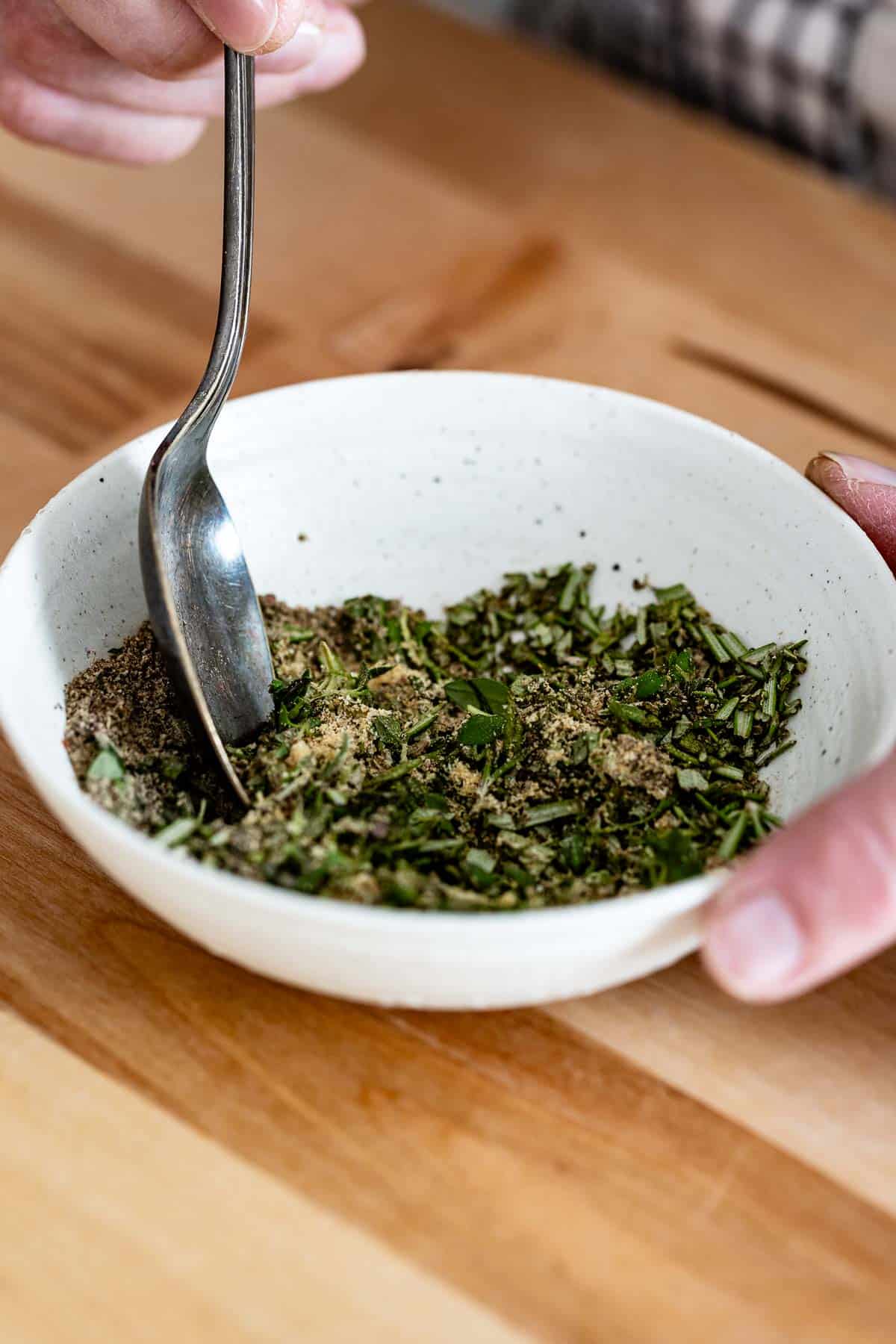
FAQs
Yes, if your recipe calls for it. Seasoning the roast with salt the night before (or even 24 to 48 hours ahead) helps draw out excess moisture and gives the salt time to work its way into the meat. This is the best way to get deeper, more even seasoning. Add the rest of the rub right before cooking.
Yes, fresh herbs work really well in this seasoning mix. But since they are milder, use twice as many dried herbs.
It depends on the cooking method and the recipe you are using, but most of the time, no. Many prime rib recipes rely on high heat at some point, and butter can burn quickly in that environment. If you want to use oil for flavor, choose one that can handle higher heat. A neutral, high-smoke-point oil like ghee (clarified butter) or vegetable oil works better than butter.
You absolutely should. The fat cap is a key part of the roast, and seasoning it will ensure that every slice is perfectly seasoned.
Yes. This seasoning works for both bone-in and boneless prime rib. Bone-in roasts take a little longer to cook, but the rub performs the same on either cut.
Complete Your Prime Rib Dinner
Congratulations, you made the best prime rib seasoning on the internet. Now, it is time to turn it into dinner. Here are the rest of the recipes you’ll need for a showstopping dinner:
- How to cook it? My go-to recipe is this Reverse Sear Prime Rib. It is a two-step cooking method that starts in a low-temperature oven, brings it to your desired doneness, and then finishes in a high-heat oven. I use this seasoning for this recipe, and it works wonderfully.
- The dipping sauce: Don’t let those herb-crusted pan drippings go to waste. Use them to make my 10-minute Prime Rib Au Jus recipe for the perfect dipping sauce.
- What to serve it with? You can’t have prime rib without horseradish sauce. Yes, you can buy it online, but making Horseradish Sauce at Home is really easy. Alternatively, if you prefer a lightened-up version, my Horseradish Yogurt Sauce might be what you need.
- Got leftovers? Don’t let a single bite go to waste and make my Leftover Prime Rib Sandwich.
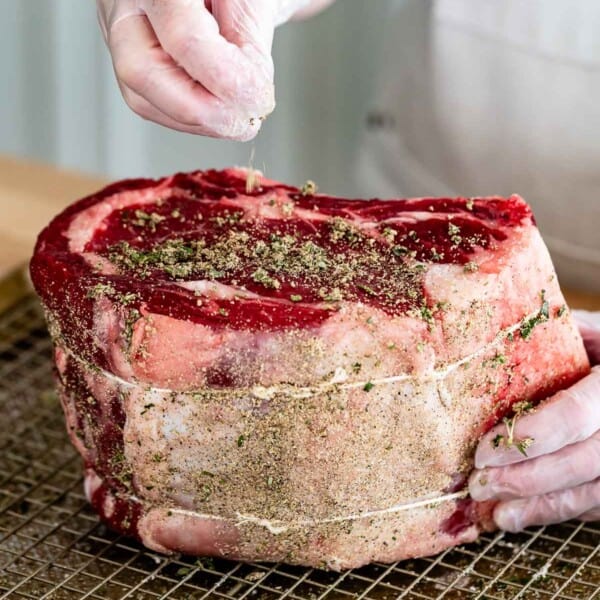

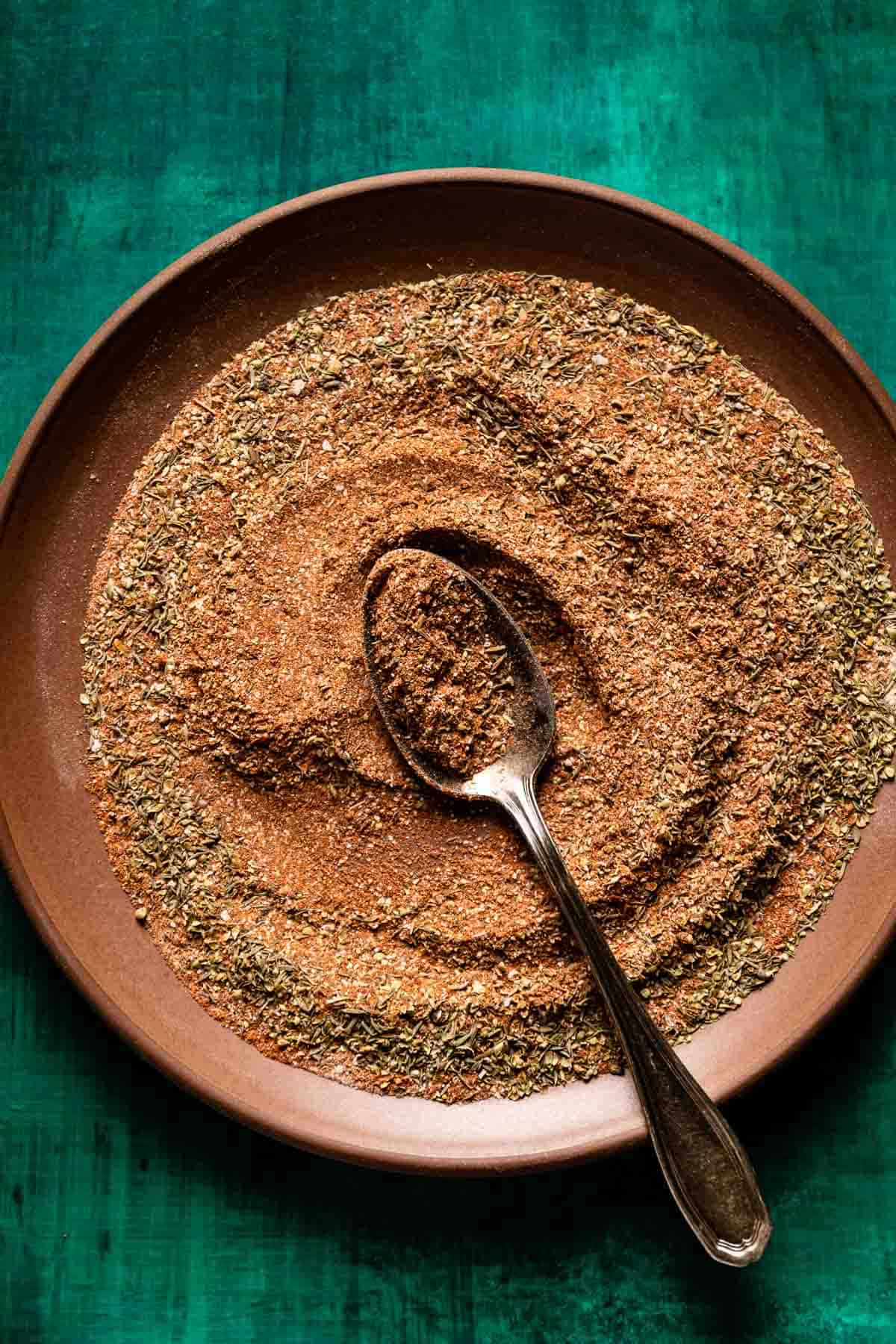
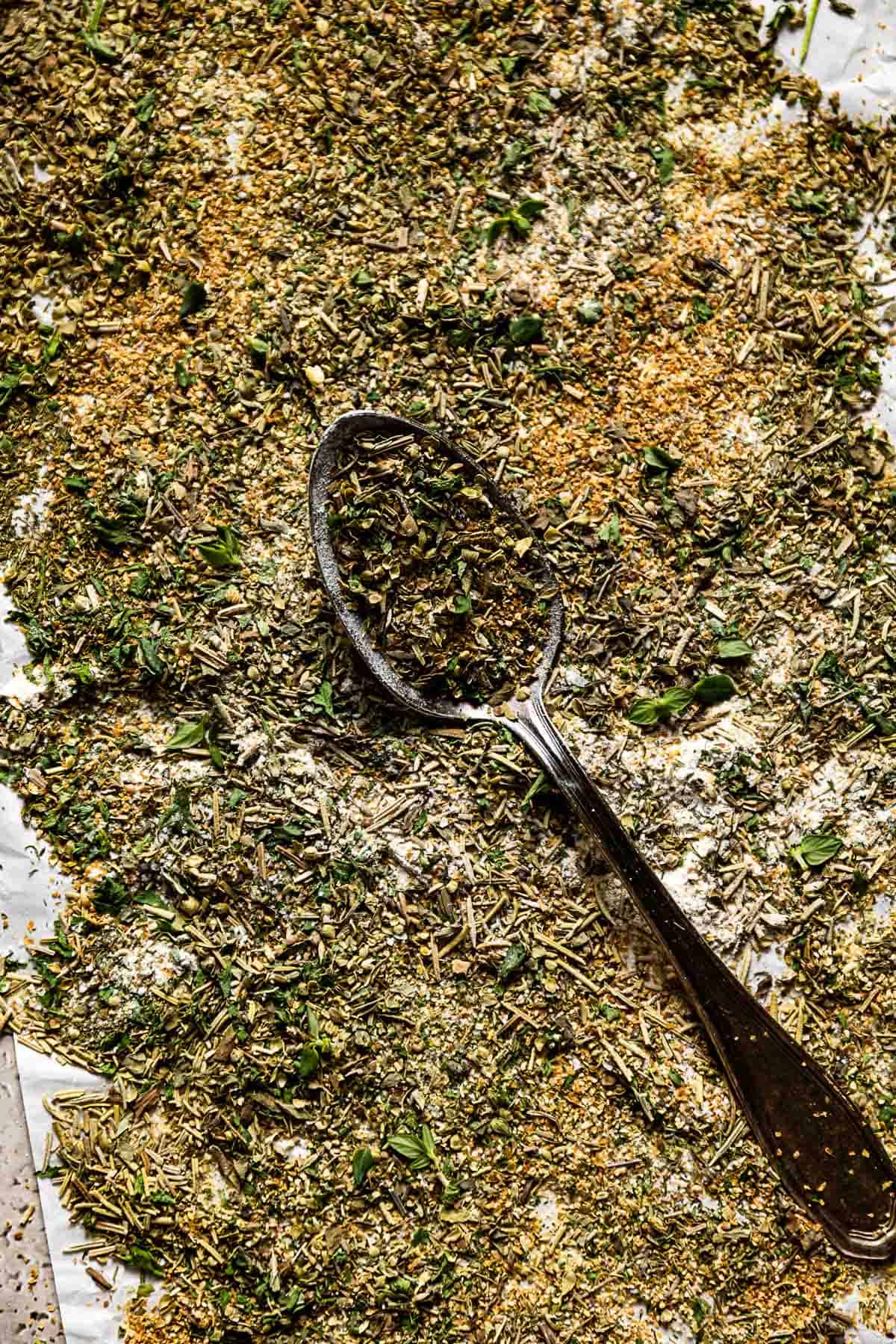
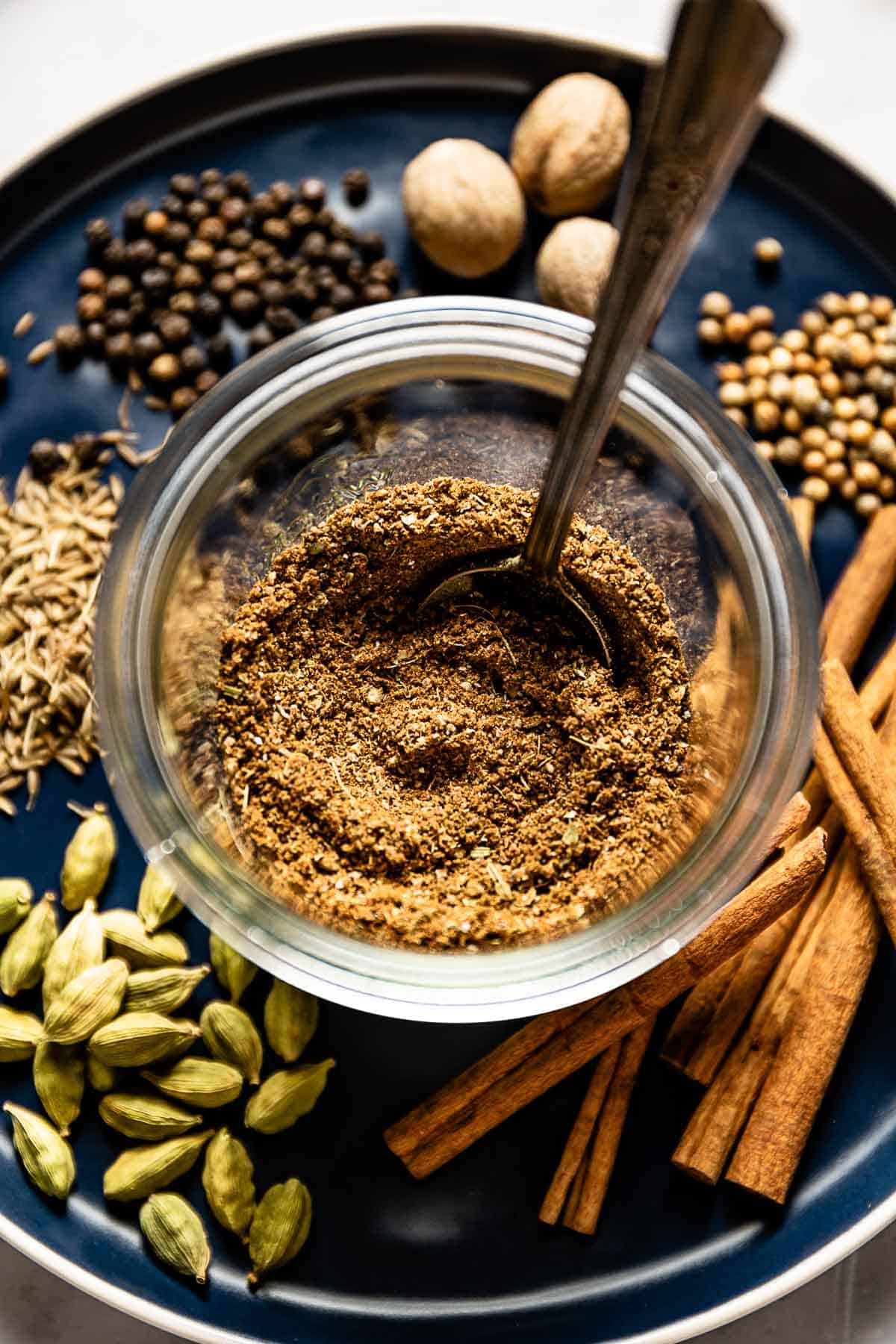










I believe dry rubs make the meats taste so much better than wet sauces. Anyone can cover in retrospect.